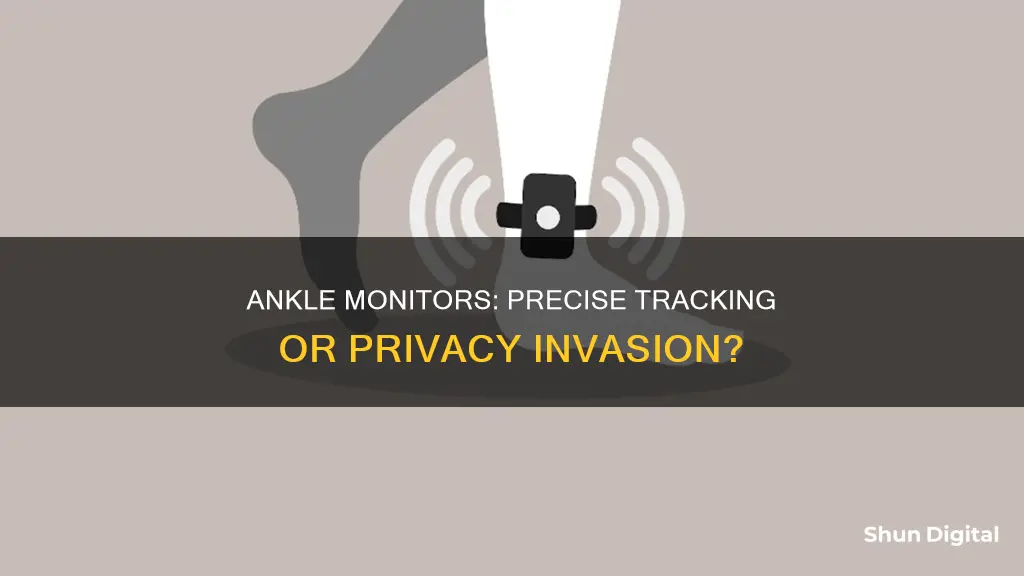
Ankle monitors are electronic devices that track and monitor an individual's location in real time. They are often used as an alternative to incarceration, allowing people to live in their homes rather than in jail. Ankle monitors use GPS and RF technology to track and report an individual's movements to authorities. While GPS provides continuous real-time tracking, RF devices monitor the presence or absence of the wearer from an exact location, making them suitable for house arrest or curfew situations. Ankle monitors help law enforcement officers supervise clients effectively while enhancing community safety.
| Characteristics | Values |
|---|---|
| Purpose | To track and monitor an individual's location in real-time |
| Technology | GPS, A-GPS, RF, and cellular data technology |
| Alerts | Notifies authorities if the wearer enters a pre-determined excluded area or moves outside of a permitted boundary |
| Use cases | Pretrial release conditions, house arrest, restraining orders, parole, probation, and community corrections |
| Benefits | Alternative to incarceration, enhances community safety, and helps supervise clients effectively |
| Features | Long battery life, user-friendly software, tamper-resistant, water-resistant, and slim design |
| Data insights | Location points, stop patterns, charging and alert analysis, travel details (arrival/departure time, address, time spent), and mapping views |
What You'll Learn
- GPS ankle monitors can track someone's location in real-time
- RF ankle monitors alert authorities if someone leaves a permitted area
- GPS and RF technology are used for ankle monitors
- Ankle monitors can be used as an alternative to incarceration
- Ankle monitors can be uncomfortable and cause skin irritation

GPS ankle monitors can track someone's location in real-time
GPS ankle monitors are a form of technology that can be used to track someone's location in real-time. They are often used as an alternative to incarceration, allowing people to live in their homes when they may otherwise be in jail. The use of ankle monitors has become increasingly popular due to technological advancements, with the number of people wearing them more than doubling from 2005 to 2015.
Ankle monitors combine GPS and cellular data technology to transmit signals with movement details to monitoring centres. This allows authorities to keep constant track of an individual's whereabouts and ensure they are complying with any restrictions on their movements. GPS ankle monitors use advanced positioning satellites and mapping software to pinpoint a person's location, which can be viewed by agents through tracking portals. This information is compiled into detailed incident logs that include locations, timestamps, and elevation changes, providing a comprehensive picture of the individual's movements.
The SCRAM GPS® Ankle Monitor Bracelet is an example of a GPS ankle monitor that provides superior location accuracy. It also features a long-lasting battery of up to 40 hours, reducing the risk of low-power alerts. The SCRAM GPS also has revolutionary tamper technology, which helps to eliminate false alerts and provides instant notifications to officers. This enables officers to quickly address any issues and enhance community safety.
In addition to real-time location tracking, GPS ankle monitors can also provide insights into an individual's travel behaviour. By analysing patterns of movement, authorities can identify stop patterns and typical travel routines. This information can be crucial in making informed decisions regarding the individual's supervision and case management.
Overall, GPS ankle monitors play a significant role in community corrections by providing a means to track and monitor individuals in real-time, ensuring their compliance with legal requirements while allowing them to remain in their homes and communities.
OptumRx: Prescription Monitoring for Customer Safety and Care
You may want to see also

RF ankle monitors alert authorities if someone leaves a permitted area
Ankle monitors are used to track the movements and activities of defendants awaiting trial and convicted offenders on parole or probation. They work using GPS or RF technology.
RF ankle monitors do not give an exact location but notify authorities when the device comes into range of or leaves a designated area. This type of monitor is often used for house arrest or curfew purposes. RF stands for Radio Frequency. The monitor works by informing the monitoring party about the general whereabouts of the device in relation to the home-based unit.
GPS ankle monitors, on the other hand, divulge specific geographical coordinates for the wearer and are very precise. They are useful for allowing individuals to travel about according to prearranged schedules and for restricting some offenders from going too near certain locations or people. GPS stands for Global Positioning System. The bracelet acts like a navigation system, continuously tracking someone in real-time and reporting the information to the authorities.
There is also a third type of ankle monitor called SCRAM (Secure Continuous Remote Alcohol Monitoring). While this can monitor location, its main purpose is to detect alcohol. It does this by periodically testing the wearer's sweat for alcohol content. SCRAM is most often used for repeat DUI (Driving Under the Influence) cases.
Ankle monitors are often used as an alternative to incarceration, allowing offenders controlled freedom. They can also be used as a condition of bail.
Monitor Overclocking: Stability Testing for Beginners
You may want to see also

GPS and RF technology are used for ankle monitors
Ankle monitors are equipped with GPS and RF technology to track an individual's location and movements. GPS, or Global Positioning System, functions similarly to a car's navigation system, tracking someone in real-time and sharing this information with authorities. This technology is especially useful for monitoring high-risk individuals, such as sex offenders, violent offenders, and those on probation or parole. GPS technology provides superior location accuracy, allowing officers to quickly identify and address issues. It also helps officers supervise clients more effectively while enhancing community safety.
On the other hand, RF (Radio Frequency) technology is primarily used for house arrest or curfew monitoring. RF devices monitor the presence or absence of the wearer from an exact location. This technology involves a transmitter affixed to the individual's ankle, which sends constant radio signals back to a receiver within a detectable range. Officers are automatically notified if the equipment is tampered with or if the individual enters or leaves a specific location.
The combination of GPS and RF technology in ankle monitors provides a comprehensive solution for tracking and monitoring individuals. GPS offers real-time location tracking, while RF ensures that the individual remains within a designated area. This dual-technology approach helps authorities ensure compliance with court-ordered restrictions, such as curfews and exclusion zones.
In addition to location tracking, ankle monitors may also have other features, such as alcohol detection through sweat analysis, further ensuring compliance with court-ordered restrictions. These devices are typically tamper-proof, and any attempts to remove them trigger instant notifications to the relevant authorities.
While ankle monitors provide increased freedom compared to incarceration, they also come with certain restrictions and potential discomfort. Wearers are often required to pay daily fees for the device, and skin irritation is a common issue. Additionally, the devices must be charged regularly, and power outages can affect their performance.
Monitor Speakers: Choosing the Right Ones for You
You may want to see also

Ankle monitors can be used as an alternative to incarceration
Ankle monitors have been used as an alternative to incarceration, particularly during the pandemic when jails were keen to reduce the number of incarcerated people due to the risk of coronavirus outbreaks.
Ankle monitors are often used to track individuals who are under the supervision of the criminal justice system. They are worn around the ankle and use GPS technology to track an individual's movements and location. They are often used for those on probation or parole, or those awaiting trial. They can also be used for individuals convicted of a crime but who are considered low-risk and not a danger to the community.
There are several advantages to using ankle monitors over traditional imprisonment. They are less expensive than keeping someone in jail or prison, and they allow individuals to maintain their jobs and support their families. This can make it easier for them to reintegrate into society once their sentence is complete.
However, there are also disadvantages. Ankle monitors can be uncomfortable and cause skin irritation. They are often subject to strict rules and regulations, and any violation of these rules can result in additional penalties or even imprisonment. The wearer must also pay for the device, which can be costly, and there are concerns about the amount of data collected and who has access to it.
While ankle monitors can be a viable alternative to incarceration in some cases, they should be used with discretion and after considering the offender's risk of reoffending and the nature of the crime.
LCD Monitors: Handling Both NTSC and PAL Signals
You may want to see also

Ankle monitors can be uncomfortable and cause skin irritation
Ankle monitors are often used as an alternative to incarceration, allowing people to live in their homes and maintain employment and education. However, the design of these monitors has not changed significantly in 30 years, resulting in bulky devices that are difficult to conceal. This makes the wearer's involvement with the justice system visible to the public, inviting prejudice and stigmatization.
The discomfort and inconvenience caused by ankle monitors cannot be overstated. Wearers report that the device becomes heavier and more painful throughout the day, causing bleeding, scarring, and foot numbness. The constant weight of the monitor can also lead to lower back problems. As one wearer describes, "the higher up I push it, the more it starts to hurt; most days, my feet go numb". The monitor's bulkiness restricts clothing choices, with some opting for flared pants or jeans to hide the device. This can be particularly embarrassing during the summer months when wearing long pants is uncomfortable.
The charging requirements of ankle monitors further contribute to the discomfort and inconvenience. The device must be charged at least once a day for up to 12 hours, requiring wearers to remain stationary near an outlet for extended periods. This limits mobility and can be challenging in public places or at workplaces without easily accessible outlets.
In addition to the physical discomfort, ankle monitors can cause skin irritation. As the device heats up during charging, it can lead to skin irritation for the wearer. This, along with the constant weight and bulkiness of the monitor, can make it challenging to find a comfortable position to sleep in.
The financial burden of ankle monitors is also significant. The daily fees for using the monitor can range from $5 to $40, and the setup fee can be as high as $200. For indigent parolees, these fees can be exorbitant, pushing them further into debt.
Monitor Driver Files: Where to Find and Download
You may want to see also
Frequently asked questions
An ankle monitor is a small, tamper-resistant electronic device worn around an individual’s ankle to track and monitor their location in real-time.
Ankle monitors contain GPS and/or RF technology, which send signals with movement details to monitoring centres. GPS technology acts like a car navigation system, continuously tracking someone in real-time and reporting the information to authorities. RF technology monitors the presence or absence of the wearer from an exact location.
Ankle monitors are used to track the movements and activities of defendants awaiting trial and convicted offenders on parole or probation. They are often used as an alternative to jail, such as for house arrest or restraining order agreements.
Ankle monitors send data to monitoring centres, which are used by authorities such as police officers.
Ankle monitors are required to be worn at all times. They cannot be removed or turned off temporarily without consequences.







